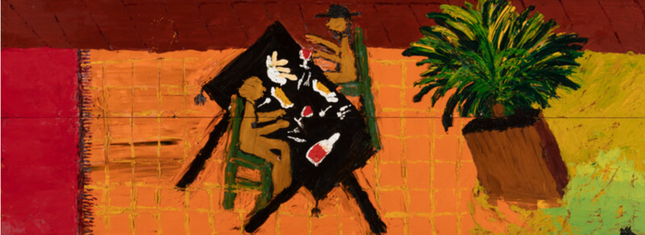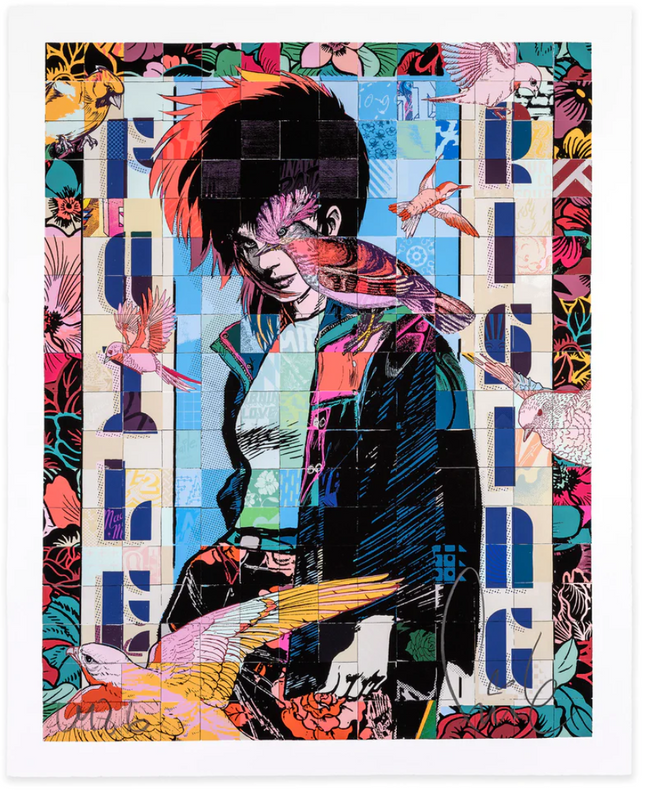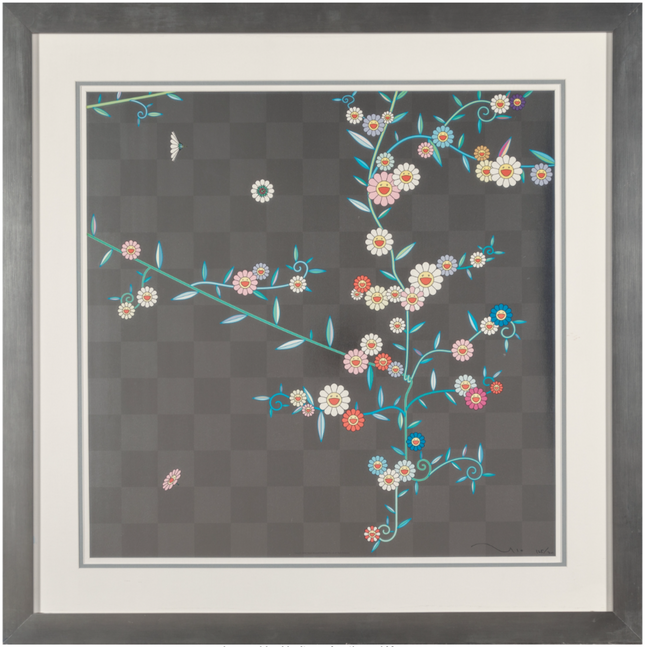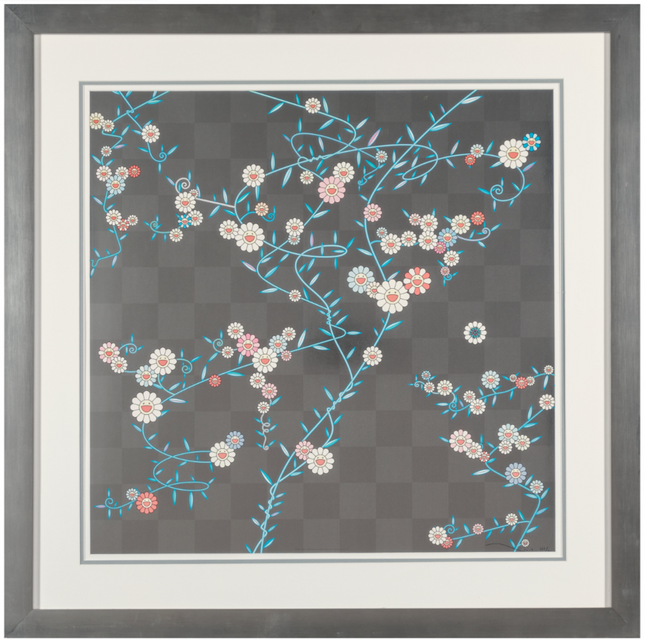
Flowers & Plants
-

Dred66- Tyree Davis Red Carpet Imperial Original Oil Painting by Dred66- Tyree Davis
Red Carpet Imperial Original Oil Painting by Dred66- Tyree Davis of a Kind of Artwork on Foam Core Mounted to Acrylic Sheet From Street Art Pop Artist. 2001 Signed Acrylic Painting Original Artwork Size 32x12 Depicting 2 People Sharing a Meal at a Table with Wine Over a Massive Red Carpet. Tagged, Signed, Dated, and titled on the Back. Imperial / Red Carpet / Dred66 / March 2001 Essence of "Red Carpet Imperial" by Tyree Davis "Red Carpet Imperial" stands as a remarkable testament to the artistic prowess of Tyree Davis, known in the street pop art and graffiti artwork community as Dred66. This original oil painting, a one-of-a-kind artwork on foam core mounted to an acrylic sheet, exemplifies the fusion of street art aesthetics with the traditional oil painting medium. Created in 2001, this signed acrylic painting stretches across a sizeable 32x12 canvas, depicting a scene that is both intimate and grandiose — two people sharing a meal at a table with a wine bottle over a massive red carpet. Davis's "Red Carpet Imperial" encapsulates the ethos of street pop art by bringing the personal into the public sphere. The subjects of the painting — two individuals engaged in the simple act of sharing a meal — are universal in their relatability. Yet, they are set against a backdrop that speaks to grandeur and excess. This contrast sketched out in the earthy yet bold tones of the oil paints, evokes a narrative that is both a celebration and a critique of cultural and social dynamics. It's a snapshot of life that is as much about the environment as it is about the individuals within it. Signature Style of Dred66 and Artistic Influence Tyree Davis's signature style is evident in how "Red Carpet Imperial" harmonizes street art's raw energy with a gallery piece's sophistication. The painting carries the hallmarks of graffiti in its background — tagged, signed, and dated by the artist, which is a nod to the graffiti tradition of artists marking their territory and claiming space. This element of the artwork connects the practice of street art with the established conventions of fine art, creating a dialogue between two worlds often seen as disparate. The tactile quality of the foam core gives the painting a three-dimensional feel. At the same time, the mounting on an acrylic sheet provides a modern twist, suggesting the protective glazing found in street art installations. These material choices by Davis reflect a thoughtful consideration of medium and message, ensuring that "Red Carpet Imperial" resonates with the authenticity of street art even as it occupies a different physical and conceptual space. In "Red Carpet Imperial," Davis offers a cultural commentary that is as relevant today as it was at the beginning of the millennium. The work's title, 'Imperial,' hints at a critique of societal structures and the seduction of luxury, a theme deep in street pop art's veins. The painting invites viewers to reflect on the disparities and contradictions that pervade modern life by placing an everyday scene in a context that implies wealth and luxury. Moreover, the painting's year of creation, 2001, situates it at a time when street art began gaining widespread recognition as a legitimate art form. Tyree Davis contributed to this burgeoning recognition through his work, bridging the gap between the street and the gallery and challenging preconceived notions about the value and place of graffiti and street pop art in the art historical canon. Legacy and Continuing Influence Tyree Davis's "Red Carpet Imperial" legacy continues influencing the street art community and the broader art world. It stands as a powerful example of how the aesthetics and themes of street pop art can be translated into different mediums and settings, maintaining their impact and resonance. Davis's work invites ongoing discourse about the intersections between art, culture, and society through its bold visual language and underlying social commentary. This conversation is as vital now as it was two decades ago. "Red Carpet Imperial" is more than just a painting; it is a piece of social fabric, a historical document, and a beacon of street pop art's enduring power to communicate, challenge, and captivate. Tyree Davis, as Dred66, has crafted an artwork that is both a reflection and a critique of the world it inhabits, securing his place in the annals of street pop art history.
$4,376.00
-

Faile Rising Archival Print by Faile
Rising Archival Print by Faile Limited Edition Print on 290gsm Entrada Cotton Rag Fine Art Paper Pop Artist Modern Artwork. 2022 Signed & Numbered Limited Edition of 350 Artwork Size 32x40 Archival Pigment Fine Art Rising Archival Print is an artwork created by Faile, a Brooklyn-based artistic collaboration between Patrick McNeil and Patrick Miller. Established in 1999, Faile has become known for their unique fusion of street art, graphic design, and fine art practices. Their works often include collage-like elements, stenciling, and screen printing, making use of various found imagery and typography. "Rising Archival Print" refers to a specific artwork within their portfolio, printed on archival-quality materials to ensure the longevity of the piece. Archival prints are produced using high-quality, acid-free paper and pigment-based inks that resist fading over time. This ensures that the colors and details of the artwork remain vibrant for many years.
$4,203.00
-

Takashi Murakami TM/KK Cosmos Offset Lithograph Print by Takashi Murakami TM/KK
Cosmos Offset Lithograph Print by Takashi Murakami TM/KK Hand-Pulled Print on Custom Framed Satin Wove Fine Art Paper Limited Edition Graffiti Street Pop Artwork. 2000 Signed & Numbered Limited Edition of 300 Artwork Size 23.5x23.5 Framed 32x32 Takashi Murakami (b. 1962) Cosmos, 2000 Offset lithograph in colors on smooth wove paper 23-3/8 x 23-3/8 inches (59.4 x 59.4 cm) (sheet) Ed. 125/300 Signed and numbered in ink lower right Published by Kaikai Kiki Co. Ltd., Tokyo Print Grade: 10/10 Matted and framed under acrylic. No apparent condition issues. Not examined out of frame. Framed Dimensions 32 X 32 Inches The "Cosmos" offset lithograph print by Takashi Murakami, created in collaboration with Kaikai Kiki in 2001, is a fine example of the Japanese artist's unique and influential work. Murakami is known for his signature "Superflat" style, which is characterized by a blend of Japanese pop culture, traditional art, and Ms Flower flowers.. In the "Cosmos" print, Murakami explores the concept of the universe, with vibrant colors, bold lines, and intricate patterns. The artwork is populated by his iconic Ms FLowerand motifs, such as smiling flowers and vines, which are deeply rooted in Japanese manga, anime, and the otaku subculture. As an offset lithograph print, the piece is created using a printing technique that involves transferring an inked image from a plate to a rubber blanket and then onto the final printing surface, usually paper. This process allows for high-quality reproductions of the original artwork, making it more accessible to a wider audience. The "Cosmos" print is a sought-after piece by collectors and fans of Takashi Murakami's work. It showcases the artist's incredible ability to merge traditional and contemporary elements, creating a visually striking representation of the universe that is uniquely his own.
$4,555.00
-

Takashi Murakami TM/KK Cube Offset Lithograph Print by Takashi Murakami TM/KK
Cube Offset Lithograph Print by Takashi Murakami TM/KK Hand-Pulled Print on Custom Framed Satin Wove Fine Art Paper Limited Edition Graffiti Street Pop Artwork. 2001 Signed & Numbered Limited Edition of 300 Artwork Size 23.5x23.5 Framed 32x32 Takashi Murakami (b. 1962) Cube, 2001 Offset lithograph in colors on satin wove paper 23-1/2 x 23-1/2 inches (59.7 x 59.7 cm) (sheet) Ed. 133/300 Signed and numbered in ink lower right Published by Kaikai Kiki, Ltd., Tokyo Print Grade: 10/10 No apparent condition issues. Not examined out of frame. Matted and framed under acrylic. Framed Dimensions 32 X 32 Inches Takashi Murakami is a renowned Japanese contemporary artist known for his unique blend of traditional Japanese art styles, such as ukiyo-e, with pop culture and Western influences. He has created a distinctive style often referred to as "Superflat" that features bold colors and graphic designs. The "Cube Offset Lithograph Print" by Takashi Murakami from 2001 is a limited edition print that features the artist's signature style vine with smiling flowers Ms Flower, with TM/KK being a reference to Takashi Murakami and Kaikai Kiki, his art production and management company. Cube Offset Lithograph is a type of printing method that produces high-quality reproductions of original artworks, often used for creating limited edition prints. Murakami's works are highly sought after by collectors and have been exhibited in prestigious museums and galleries worldwide. Owning a limited edition print like the "Cube Offset Lithograph Print" could be considered a valuable addition to an art collection.
$4,555.00







 العربية
العربية 简体中文
简体中文 Dansk
Dansk Nederlands
Nederlands Filipino
Filipino Suomi
Suomi Français
Français Deutsch
Deutsch Ελληνικά
Ελληνικά עִבְרִית
עִבְרִית हिन्दी
हिन्दी Íslenska
Íslenska Bahasa Indonesia
Bahasa Indonesia Italiano
Italiano 日本語
日本語 한국어
한국어 Latin
Latin Bahasa Melayu
Bahasa Melayu Norsk bokmål
Norsk bokmål فارسی
فارسی Português
Português Español
Español Svenska
Svenska ไทย
ไทย Türkçe
Türkçe Tiếng Việt
Tiếng Việt